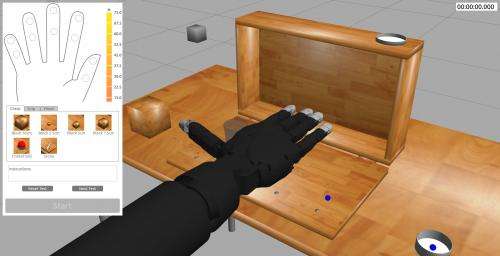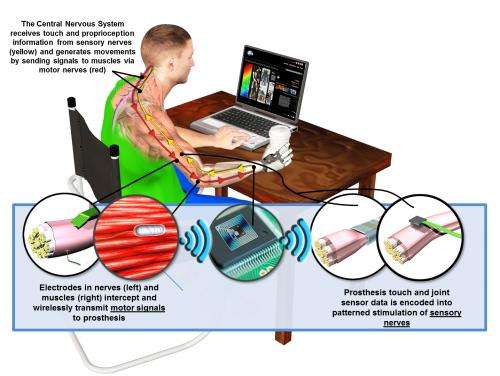HAPTIX starts work to provide prosthetic hands with sense of touch

Despite recent advances in technology for upper-limb prostheses, artificial arms and hands are still unable to provide users with sensory feedback, such as the "feel" of things being touched or awareness of limb position and movement. Without this feedback, even the most advanced prosthetic limbs remain numb to users, a factor that impairs the limbs' effectiveness and their wearers' willingness to use them. In a step toward overcoming these challenges, DARPA has awarded prime contracts for Phase 1of its Hand Proprioception and Touch Interfaces (HAPTIX) program.
As part of DARPA's commitment to help restore full and natural functionality to wounded Service members and veterans, and in support of the White House brain initiative, HAPTIX seeks to create a prosthetic hand system that moves and provides sensation like a natural hand. Sensory feedback, especially from the hand, is vitally important for many functions, and HAPTIX seeks to create a sensory experience so rich and vibrant that users would want to wear their prostheses full time. By restoring sensory functions, HAPTIX also aims to reduce or eliminate phantom limb pain, which affects about 80 percent of amputees.
Speeding development of vastly improved upper-limb prostheses has become a national priority. President Obama referred to DARPA's numerous advanced prosthetics programs in his 2015 State of the Union address last month when he said the U.S. government is interested in "creating revolutionary prosthetics, so that a veteran who gave his arms for his country can play catch with his kids again" (see video at ow.ly/IyJMJ).
"The ultimate goal for HAPTIX is to create a device that is safe, effective and reliable enough for use in everyday activities," said Doug Weber, DARPA program manager. "DARPA is partnering with scientists at the Food and Drug Administration to help develop standards for verifying safety and quantifying benefits of this new class of advanced technologies. We hope to streamline the process of validating technologies that can help our military Service members and veterans who have been injured while serving our country."
DARPA is evaluating several distinct technical approaches in Phase 1. Those that prove successful would continue into Phase 2, which would integrate selected technology components into a complete HAPTIX test system. The agency plans to initiate take-home trials of a complete, FDA-approved HAPTIX prosthesis system within four years.
The name HAPTIX is a play on the word haptics, referring to the sense of touch. The program plans to adapt one of the prosthetic limb systems developed recently under DARPA's Revolutionizing Prosthetics program to incorporate interfaces that provide intuitive control and sensory feedback to users. These interfaces would build on advanced neural-interface technologies being developed through DARPA's Reliable Neural-Interface Technology (RE-NET) program.
Where appropriate, HAPTIX teams intend to leverage commercially available technologies such as intramuscular electrodes and lead technologies developed initially for cardiac pacemakers and now used in several modern implantable medical devices. The program also plans to test advanced microelectrode array and nerve cuff electrode technologies that have been developed over the past two decades with support from the National Institutes of Health, the Department of Veterans Affairs and DARPA.

DARPA is working with teams led by the following institutions:
- Case Western Reserve University
- Cleveland Clinic
- Draper Laboratory
- Nerves Incorporated
- Ripple LLC
- University of Pittsburgh
- University of Utah
- University of Florida
To help the performers more quickly and cost-effectively conduct their research, DARPA is providing prosthetics simulation software for testing designs. The software includes a variant of the DARPA Robotics Challenge (DRC) Simulator from the June 2013 Virtual Robotics Challenge, which helped to expedite the initial design and evaluation of semi-autonomous robots that could aid in emergency response efforts.
"The DARPA Robotics Challenge Simulator was a big help for DRC and we immediately saw how adapting its virtual testing environment could benefit HAPTIX research," Weber said. "The simulator will enable rapid and low-cost development of the HAPTIX technology and also provide amputees with a realistic experience for learning to use their physical prosthesis."
Provided by DARPA




















